Summary
– Pork is the most widely consumed meat in the world. It’s a good source of complete protein and several important vitamins and minerals.
– Saturated fat and cholesterol have not been proven to cause cardiovascular disease. Pork tenderloin and sirloin meet American Heart Association criteria for heart-healthy eating.
– Lean pork can be made more flavorful by using a brine or spices, and by adding fruit, acidity, herbs, extra fat, or mustard to your recipe.
Healthy Pork Recipes & Ideas That Taste Great
Pork is so much more than bacon and sausage. Because it’s so prevalent in fast food and decadent restaurant meals, it seems that many people have gotten the wrong impression that pork is an inherently fattening food. The truth, however, is that it’s packed with protein and can be quite lean—comparable to chicken breast. Fattier cuts probably do need to be consumed in smaller portions if you’re watching your weight, but they can deliver an awful lot of flavor—at a minor caloric cost—in small doses.
This is our guide to “the other white meat” (that actually isn’t white), covering everything from its nutrition properties to some of the best ways to prepare it.
Is Eating Pork Bad For You?
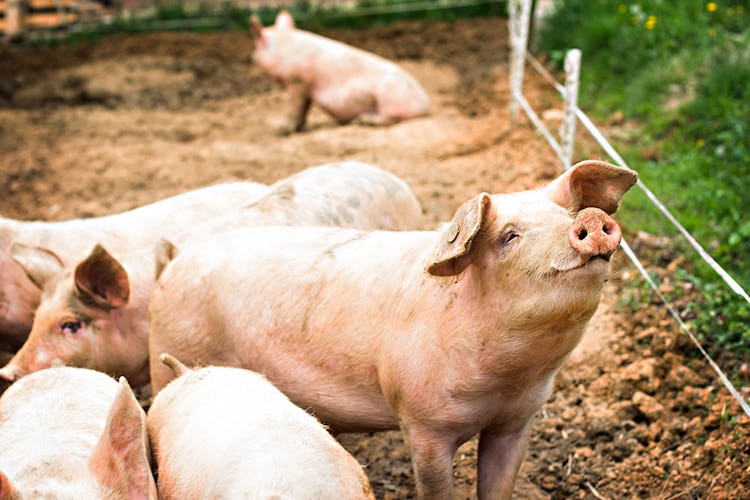
Here’s our theory on why some people squeal at pork: Pork comes from pigs. Pigs tend to be fat, and their meat contains fat. Therefore, eating pork will turn you into a pig.
Or something along those lines…
Fortunately, most of the world doesn’t follow that logic. According to the U.N. Food and Agriculture Organization, 36% of the meat consumed internationally is pork—which means that pork is the most widely eaten meat in the world (but poultry isn’t far behind, at 33%).
There are plenty of reasons to dine on swine. For one, pork is high in protein. “It’s considered to have complete protein,” says Chris Mohr, PhD, RD, a nutrition and wellness consultant (follow him on Instagram, @mohrresults). “That means that pork contains all the amino acids your body needs to build and maintain muscle, bone, and all its other tissues.” Pork is also a good source of vitamins and minerals, particularly B vitamins, iron, and zinc. B vitamins are crucial for energy production and a healthy metabolism, iron supports red blood cells and helps to make hormones, and zinc promotes brain and immune system health. (Read more about B vitamins in our guide.)
Pork offers some other nutrients that are especially important for active, fit people. Like other meats, pork has creatine, which helps to power muscle contractions (and a lot more—read our creatine guide). It also has taurine, an amino acid that can help protect against cellular damage and support heart function. Finally, pork contains beta-alanine, another amino that can help promote work capacity in the gym (yes, we have a guide for beta-alanine too).
The big knock on pork is that it contains saturated fat and cholesterol, like all red meats. (Despite marketing hype that would indicate otherwise, pork is not a white meat—more about this below).
If your doctor has advised you to steer clear of pork, and foods that are high in saturated fat and cholesterol in general, we won’t try to convince you otherwise. But if you’re a regular, healthy person, science shows that fearing these nutrients is probably unwarranted.
The American Heart Association’s practical guidelines state that a moderate intake of cholesterol does not affect blood cholesterol levels in most people. Furthermore, a review in the American Journal of Clinical Nutrition indicated that some saturated fats actually lower LDL cholesterol. Still, other research shows that reducing saturated fat in the diet without considering other nutritional factors won’t reduce the risk of cardiovascular disease.
Even if you are concerned about saturated fat in your food, pork can still be a part of your plate. “Both pork tenderloin and pork sirloin roast meet the criteria for the American Heart Association Heart Checkmark,” says Mohr, “which means they contain less than 5 grams of fat, 2 grams or less of saturated fat, and 480 milligrams or less of sodium per label serving.”

Of course, the pork family also consists of processed meat products, such as bacon and sausage, which have been linked to illnesses, including cancer. These meats are often cured with nitrates and nitrites, types of preservatives, which, once cooked, can form carcinogenic compounds called nitrosamines. However, many suppliers try to offset the risk by adding vitamin C and other antioxidants to bacon and sausage during the curing process, which reduces the nitrosamine content.
Another option is to buy bacon and sausage that advertises no added nitrates, but this isn’t a guarantee that the meat is any healthier. Celery powder is sometimes used as an alternative to synthetic nitrates and nitrites, but it has the same effect in preserving the meat, and it hasn’t been proven to be less risky.
Bacon is also high in fat and salt. While dietary fat may not play a significant role in heart disease, it is calorie-dense, so people watching their weight should avoid it in high amounts (unless you’re following a low-carb diet, in which fat is substituted for a high-carb intake, and still manages to create a calorie deficit). Salt, meanwhile, may increase the risk of high blood pressure, but probably only in those who have a sensitivity to it. Still, it’s best to let most of your sodium intake come from whole foods and seasonings used to flavor them, not processed foods, so you don’t take in too much.
The bottom line on bacon and sausage is to treat them as an indulgence that you eat now and then—not as a diet staple. But you should have no problem eating leaner, minimally-processed pork products, such as tenderloin, on a regular basis, if you so choose.
You may have also read about pork carrying certain parasites that can be harmful. This is a possibility, but it’s only a real concern in developing countries where farming and meat processing procedures aren’t held to the highest standards. An article in Clinical Microbiology and Infection states that the risk of contracting a pork-born parasite in a developed country is minimal, provided you only consume meat that’s been cooked through. So the pork you get at Walmart is almost certainly safe to eat, as long as you heat it until it’s no longer pink and soft inside.
How Does Pork Compare Nutritionally To Other Types of Meat?
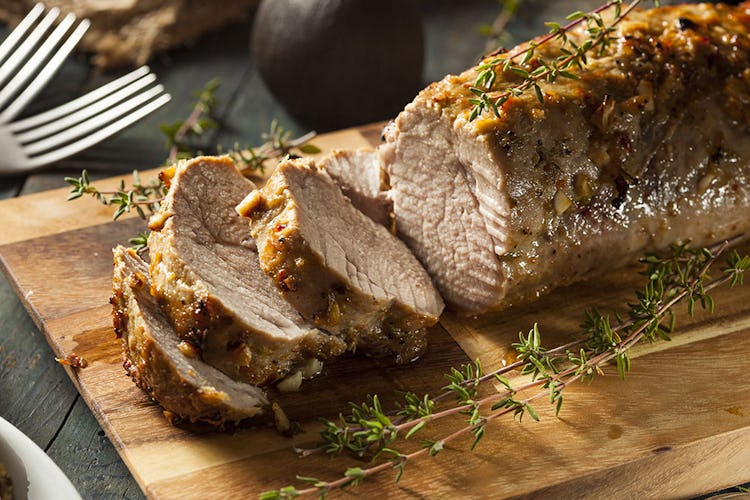
Lean pork products are on par with other types of meat, health-wise. As with all meats, pork is naturally carb-free, and high in protein. Though it’s been marketed for decades as a white meat, pork is technically red meat, like beef, but all this means is that a certain protein in meat, called myoglobin, produces a red color when it’s exposed to air.
The cut of pork that offers the best combination of high protein and low calories/fat is pork tenderloin. In this regard, it’s almost identical to skinless chicken breast and turkey breast. It’s also much leaner than most lean cuts of steak, such as sirloin. Boneless loin roast and loin chops are also good options. See how these meats compare below.

And what about ham? If you’re making a sandwich, the extra-lean, low-sodium variety is your best bet. A 3.5 oz serving has only 140 calories for 19g protein and 3g fat—but the sugar used to cure the ham brings the carbs in at around 11 grams. Canadian bacon is a better choice, as one slice has only 20 calories for 4 grams protein and less than a half-gram of fat and carbs.
Bear in mind that the nutritional quality of any meal depends largely on how it’s prepared. To control calories, opt for baking, broiling, grilling, or roasting pork, as opposed to frying it, or cooking it with large amounts oil.
You should also try to get organic pork whenever possible, or look for brands that are antibiotic- and hormone-free, and pasture-raised. This provides greater assurance that the pigs lived healthy lives and were treated humanely, and that means better nutrition and flavor (as well as karma for you).
Remember also that a pork dish by itself is never good or bad. The same can be said of virtually any food. If you’re watching your weight, you have to keep track of what you’re eating at all your meals. Whole eggs and bacon at breakfast, grilled salmon at lunch, and pork tenderloin for dinner isn’t an unhealthy day of eating, per se, but it will add up to a lot of calories. One who’s trying to lose weight, and isn’t following a low-carb/higher-fat diet, should consider subbing some lower-fat, protein-rich foods—such as chicken breast, turkey, and white fish—for higher-fat fare like bacon and salmon, to avoid excess calories.
“At the end of the day, it’s about balance,” says Mohr, “and what else is on your plate as well.”
7 Helpful Pork Cooking Tips
If you’ve had pork dishes turn out dry or bland in the past, follow these seven suggestions from Liv Langdon (livoutloud.com), a holistic wellness coach and recipe developer, for delicious meat every time.
1. Bring In A Brine
Lean cuts of pork are easy to overcook, and doing so will leave you with a tough, dry piece of meat. You can lock in moisture by brining the pork before cooking. All you have to do is soak it in a saltwater solution (a wet brine), or coat it in salt (a dry brine) and let it sit in the fridge for 45 minutes, or overnight. Dry brine is preferable to wet because the latter tends to dilute the resulting flavor, while a dry brine can enhance it.
2. Spice It Up
Pork is a pretty mild-tasting meat, so if you want bolder flavor, don’t be shy about adding spices. Smoked paprika is a game-changer; it’s one of those spices you should have on hand at all times. It adds a smoky flavor to whatever you’re cooking that is simply delectable. Add it to your dry brine, or throw it in your ground pork kale sauté (shown below) to turn up your breakfast tacos.
3. Pair With Sweetness
Pork goes really well with sweet flavors. Whether you make a sauce, marinade, or dressing, a touch of natural sweetness goes a long way toward making pork more delicious. Think apples, pears, or raw honey!
4. Balance With Acidity

Whether it’s a wedge of lime with your breakfast tacos, balsamic vinaigrette on your salad, or apple cider vinegar in your spiced apples (see below), a touch of tartness really elevates any dish.
5. Level Up With Herbs
Fresh herbs make whatever you’re serving look fancier (and taste better, too!). When you sear pork chops in fresh thyme sprigs, you immediately add an extra layer of flavor without adding calories, and it takes no extra effort. Rosemary is another great option.
6. Use Fat For Flavor
Pork is healthiest when it’s lean, but cutting the fat can also mean cutting flavor. If you’re trying to keep your fat intake lower, but still want to maximize taste, consider using a lean cut of pork like tenderloin along with a slightly fattier cut like pork shoulder. Adding a little fat with the shoulder can pile on flavor without pumping up the calories too much.
7. Add Mustard
If you can’t be bothered to make a brine, marinade, glaze, or any special sauce for your meat, then you must have mustard on hand. It pairs so well with pretty much every cut of pork that you should have whole-grain, Dijon, and honey-mustard always at the ready.
Healthy Pork Recipes
Pulled pork… Pork chops… Bacon?? To most people’s ears, they sound like foods you should avoid if you want to eat healthy. But the way you prepare them, and the foods you include alongside (or leave out), can do a lot to round out the nutrition profile of your meals, save calories, and promote satiety without sacrificing flavor. Langdon offers the following options.
DINNER: Slow-Cooked BBQ Pulled Pork Sandwiches with Coleslaw
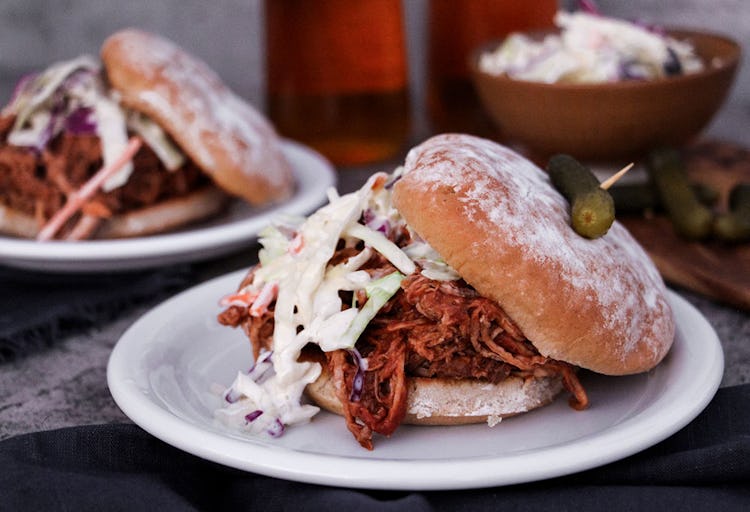
Prep time: 15 minutes
Cook time: 3–4 hours on high, 5–6 on low
Serving size: 1 sandwich
Yields: 8 sandwiches
PULLED PORK INGREDIENTS
1 lb. pork tenderloin
1 lb. pork shoulder
4 cans Zevia Ginger Root Beer*
10 oz. no-sugar-added barbeque sauce**
8 Whole-grain artisan-style burger buns***
Dill pickles (optional)
COLESLAW INGREDIENTS
2 cups shredded cabbage
¼ cup avocado oil mayonnaise****
¼ cup full-fat plain Skyr or Greek yogurt
1 tsp. Dijon mustard
2 tsp. apple cider vinegar
½ lemon
Salt and pepper, to taste
*This specific brand is free of refined sugar, contains no artificial dyes, and is sweetened with stevia.
**We used Good Food for Good Organic Classic BBQ Sauce. It’s sweetened with dates and has 3g sugar per serving.
***We used Dave’s Killer Bread USDA Organic Burger Buns Done Right. They’re free of high-fructose corn syrup and bleached flour.
****We used Primal Kitchen avocado oil-based mayonnaise
INSTRUCTIONS
Step 1. Add the meat to a slow cooker, and cover with the Zevia ginger root beer. Cook on low 5–6 hours, or on high 3–4 hours, depending on when you want it finished.
Step 2. Add all of the slaw ingredients to a mixing bowl. Stir to combine. You can prepare the slaw the day before. The longer it sits in the fridge, the better it tastes!
Step 3. When the meat is finished cooking, transfer it to a large cutting board and shred with two forks. Transfer the shredded meat to a large mixing bowl, and toss it with the barbeque sauce.
Step 4. Serve on a warm burger bun with a scoop of slaw. Pickles and beer are optional (but encouraged!).
SIDE DISH: Crispy Bacon Brussels Sprouts with Whole-Grain Mustard Sauce
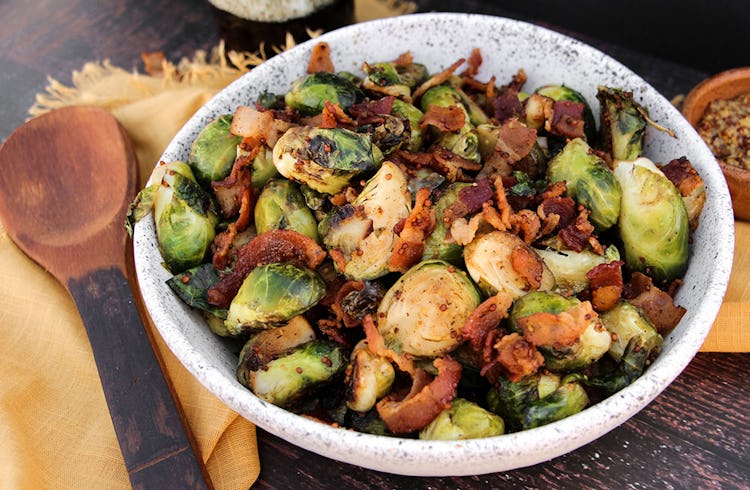
Prep time: 15 minutes
Cook time: 20 minutes
BACON AND BRUSSELS SPROUTS INGREDIENTS
6 slices bacon (preferably with vitamin C added, or uncured/nitrate-free)
5 cups Brussels sprouts, halved and trimmed
¼ tsp. garlic powder
Salt and pepper, to taste
MUSTARD SAUCE INGREDIENTS
¼ cup whole-grain mustard
1 tbsp. Dijon mustard
3 tsp. apple cider vinegar
2 tbsp. raw honey
INSTRUCTIONS
Step 1. Place a cast-iron skillet over medium-high heat. Cut bacon strips into small, ½-inch thick pieces, and add to the pan. Cook, stirring occasionally, until crispy.
Step 2. Transfer the bacon bits to a paper towel-lined plate. Discard most of the rendered fat, but leave 1 tbsp. in the pan.
Step 3. Add the Brussels sprouts, garlic, salt, and pepper to the pan. Cook until the sprouts’ edges are golden brown, and they’re fully cooked—approximately 10 minutes.
Step 4. While the Brussels sprouts cook, make the mustard sauce in a small mixing bowl, whisking together all the ingredients. When the Brussels are done, remove from heat. When they’re slightly cooled, toss in the mustard sauce and bacon bits, and serve warm.
DINNER: Pan-Seared Pork Chops with Spiced Apples
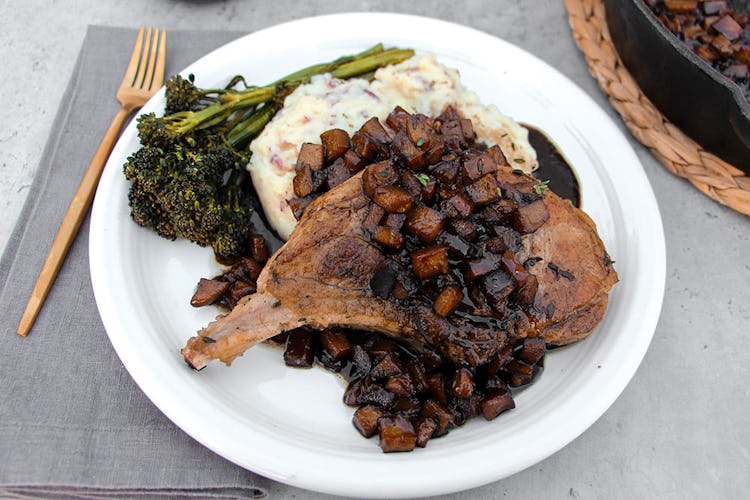
Prep time: 15 minutes
Brine Time: 45 minutes
Cook time: 50 minutes
PORK CHOP INGREDIENTS
2 bone-in pork chops, about 1-inch thick
Ghee (or high-smoke point oil of choice, like avocado oil or rendered bacon fat)
1 tbsp. grass-fed butter
4 cloves garlic
6 sprigs fresh thyme
Black pepper and sea salt, to taste
DRY BRINE INGREDIENTS
2 tbsp. salt, or enough to generously coat the meat
1 tbsp. coconut sugar
1 tsp. garlic powder
1 tsp. smoked paprika
SPICED APPLES INGREDIENTS
1 Granny smith apple, peeled, cored, and diced
1 tbsp. grass-fed butter
Dash of ground cinnamon
Dash of ground cloves
⅓ cup apple cider vinegar
⅓ cup coconut sugar
1 tbsp. maple syrup
SIDES
6 red-skinned potatoes
1 tbsp. grass-fed butter
garlic, to taste
salt and pepper, to taste
Head of broccolini, trimmed
1 tbsp. extra-virgin olive oil
1 tbsp liquid aminos (we used Bragg’s Liquid Aminos)
1 tsp. garlic powder
INSTRUCTIONS
Step 1. Rinse the pork chops, and pat them dry. Mix the spices for the dry brine, and completely coat the chops. Keep in the fridge 45 minutes, or overnight if you have the time.
Step 2. Boil the potatoes until you can easily pierce them with a fork. Mash the potatoes, and add flavor with 1 tbsp. butter, garlic, salt, and pepper.
Step 3. Toss the broccolini in the olive oil, liquid aminos, garlic powder, salt, and pepper, and roast in a 350-degree oven for 30 minutes.
Step 4. Meanwhile, lightly coat a cast-iron skillet with the ghee, and place over high heat until smoking. Add the pork chops, and flip until all sides have a golden crust—about 5–7 minutes.
Step 5. Add the butter, garlic cloves, and fresh thyme to the skillet. Continue cooking and flipping frequently for an additional 5 minutes, or until the internal temperature of the pork reads 135 degrees Fahrenheit (medium doneness). Remove the chops from the heat, and let the meat rest 5 minutes before serving.
Step 6. Discard thyme sprigs and garlic cloves, but leave the remaining oils, thyme leaves, and brown bits on the skillet to flavor the apple.
Step 7. Add the diced apple and butter to the skillet and turn heat to medium-high. Stir and cook the apples until softened. Then add the spices, vinegar, coconut sugar, and maple syrup. Lower the heat to medium-low, and reduce to a syrup consistency, about 6 minutes. Serve the spiced apple over the pork chops, and with the mashed potatoes and broccolini on the side.
Healthy Pork Tenderloin Recipe
Tenderloin makes for a lean lunch or dinner. With the addition of fruit, spices, and some acidic ingredients, you can offset any blandness that comes with lower-fat meat and provide an amazing array of flavors. Langdon conjured up this salad to illustrate.
Pear + Blue Cheese Arugula Salad with Grilled Pork Tenderloin
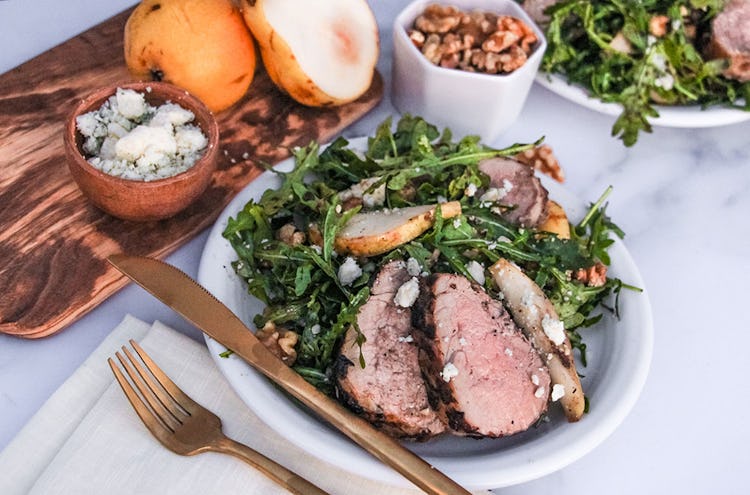
Prep time: 10 minutes
Brine time: 45 minutes
Cook time: 25 minutes
SALAD INGREDIENTS
12 oz. pork tenderloin
Avocado oil, or other oil with high smoke point
3 cups arugula
2 Bartlett pears, cored and thinly sliced
⅓ cup crumbled blue cheese
½ cup walnut halves
DRY BRINE INGREDIENTS
2 tbsp. salt, or enough to generously coat the meat
1 tbsp. coconut sugar
1 tsp. garlic powder
1 tsp. smoked paprika
VINAIGRETTE INGREDIENTS
¼ cup aged balsamic vinegar
¼ cup extra-virgin olive oil
2 tbsp. raw honey
1 tsp. minced garlic
1–2 tbsp. fresh thyme, or herbs of choice, finely chopped
Salt and pepper, to taste
INSTRUCTIONS
Step 1. Rinse the tenderloin and pat it dry. Mix the spices for the dry brine, and completely coat the tenderloin. Cover and store in the fridge 45 minutes, or overnight if you have the time.
Step 2. Fire up the grill! A cast-iron skillet works well here too. Lightly coat the grill or pan with a high-smoke point oil (such as avocado or almond) to prevent sticking. If using a pan, set it over high-heat, until the oil begins to smoke. Add the pork tenderloin and cook, turning occasionally, until browned on all sides—about 10 minutes.
Step 3. Once the pork’s edges are crisp and brown, turn the heat down to medium-low, and cook an additional 10–15 minutes covered, until the internal temperature reaches 130 degrees Fahrenheit (use a meat thermometer to check). Remove the pork from the heat and let it rest 5 minutes before slicing.
Step 4. While the pork cooks, whisk the vinaigrette ingredients together in a small mixing bowl until combined. Or, if you prefer, skip this step, and use your favorite salad dressing instead.
Step 5. In a large bowl, add the arugula, pears, walnuts, cheese, and vinaigrette. Toss to combine. Plate and serve with the tenderloin.
Healthy Ground Pork Recipe
For those watching their carbs or watching out for gluten, Langdon created these tacos. They make a great breakfast (with leftovers that can supply a lunch or dinner the next day). The tortillas are grain-free, but offer much the same texture and taste as conventional flour ones.
Ground Pork Al Pastor Breakfast Tacos
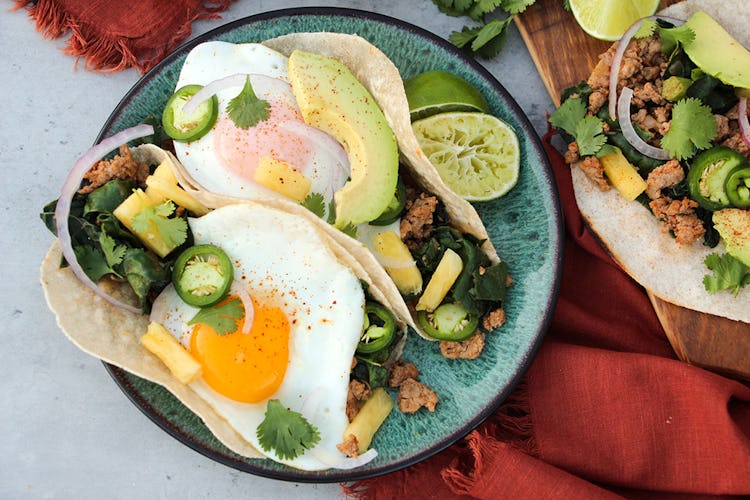
Prep time: 10 minutes
Cook time: 15 minutes
Yields: 6 tacos
TACO INGREDIENTS
1 tsp. avocado oil
¼ red onion, diced
1 lb. ground pork
2 tsp. chili powder
1 tsp. smoked paprika
½ tsp. garlic powder
Salt and pepper, to taste
½ orange, juiced
½ lime, juiced
5 oz kale (or ½ of 10-oz bag)
6 eggs
Tortillas (we used Siete Grain-free Coconut Cassava Tortillas)
TOPPINGS
Avocado, sliced
½ cup pineapple chunks, chopped into ½-inch thick pieces
2 jalapenos, sliced into rounds
¼ red onion, thinly sliced
4 sprigs fresh cilantro, stems removed
2 limes, cut into wedges
Hot sauce, to taste
INSTRUCTIONS
Step 1. In a large sauté pan, add the avocado oil and the diced onion. Cook 2–3 minutes over medium heat until onion is translucent.
Step 2. Increase the heat to medium-high, and add the ground pork. Break up the meat as it begins to brown.
Step 3. Add the spices, orange juice, and lime juice, and continue to cook thoroughly.
Step 4. When the meat is browned, turn the heat down to medium-low, add the kale, stir, and cover until wilted—about 2–3 minutes.
Step 5. Transfer the pork and kale mixture to a bowl, and cover to keep warm.
Step 6. In the same pan, cook the eggs in whatever style you prefer. While they cook, warm the tortillas.
Step 7. Assemble tacos with the pork-kale mixture on the bottom, then top with egg, avocado, pineapple, jalapeno, onion, and fresh cilantro. Serve with a lime wedge.
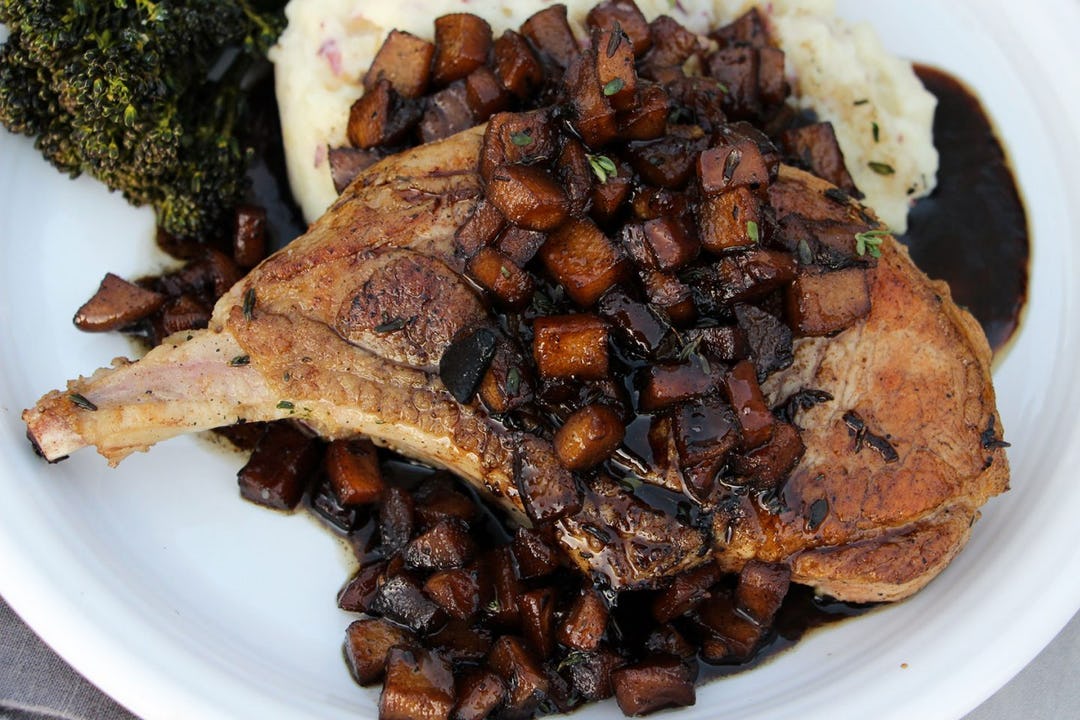
)





